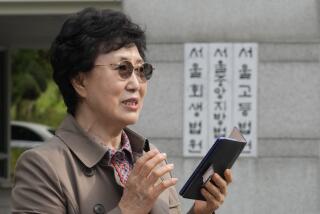Adoption Secrecy Gives Way to a New Openness
WASHINGTON — Becca Price and her husband, Christopher Clayton, decided that they wanted to see a movie. As parents typically do when planning a Saturday night out, they arranged for a baby sitter.
But Thea Grimes-Tenney, the woman who sat with David, 5, and Tori, 4, was anything but typical. She is the children’s biological mother.
The Claytons and Grimes-Tenney, who live near each other in the Ann Arbor, Mich., area, have added an unusual twist to the idea of the “extended family.”
Theirs includes the Claytons and their two children through adoption--and the woman who gave birth to them. “Thea is their birth mother, and I am their mommy,” Price said.
Adoption policies have undergone a stunning transformation from the not-so-distant past, when records were sealed and children’s biological roots were shrouded in secrecy.
In increasing numbers, those adopted today not only know the identity of their birth parents but, with their adoptive parents’ blessing, often maintain a relationship with them. The majority of domestic adoptions, experts in the field say, now feature some degree of openness.
The extent of the openness varies greatly. At the low end, the birth and adoptive parents merely know one another’s first names and exchange information through a third party. At the high end, it is the sort of arrangement maintained by the Claytons and Grimes-Tenney, the “family Thanksgiving dinner” model, as one adoption agency director calls it. In this category, she said, “the West Coast is probably 5 to 10 years ahead of the East Coast.”
The term “openness” is, “unfortunately, a scare word that sounds like some crazy thing . . . like ‘open marriage,’ ” said Bruce M. Rappaport, executive director of the Independent Adoption Center, an agency based in Pleasant Hill, Calif.
“For years, we tried to call it ‘normalized’ adoption because it means approaching adoption the same way you do the regular part of your life,” he said. “Open adoption makes adoption normal. As in the rest of our society, secrecy and shame are avoided unless absolutely necessary.”
The trend “is not so far apart from the communal living” embraced by many cultures and “fits what other societies do, where there is no nuclear family,” said Yale University child-development specialist Edward Zigler.
Before secrecy laws, many of which date to the 1940s, “most adoptions were done within people’s own families or with someone close by in the church or community,” Rappaport said. “Everyone did know everyone else, and they were, in fact, open adoptions, although they weren’t called that.”
The new wave of openness began after adults who had been adopted as children initiated searches and legal battles, seeking to find the missing pieces of their lives. Experts now recognize that adopted children are often vulnerable to emotional and psychological damage if they grow up denied this information.
“Adoptees came out of the closet, just like many other groups in society--gays, single parents--that didn’t fit into the ‘50s, and said they weren’t going to suffer in silence anymore,” an agency director said.
Also, the growing incidence of special-needs adoptions, which typically involve the placement of older children “who know where they come from,” showed that “the sky didn’t fall in,” said Ann Sullivan, adoption program director for the Child Welfare League of America.
“Initially, I had some great concerns about the concept of open adoption. I was very uncomfortable with it,” Sullivan said. “But now I’m very supportive.”
Experts recommend extensive counseling in advance so that the limits of the arrangements are well defined. No matter how well the ground is prepared, however, there can be tremors along the way.
“It’s like getting a set of in-laws,” Sullivan said. “Some of us love our in-laws, and others grit their teeth and communicate only at Christmas.”
Grimes-Tenney, the birth mother of David and Tori, admits to a few rough spots in her relationship with Price and Clayton.
“We’re making this up as we go along,” Grimes-Tenney said. “There haven’t been a whole lot of things we’ve rabidly disagreed on, but I’d be lying if I said it was easy. There’s no road map for something like this.”
Grimes-Tenney grew up in what she describes as a dysfunctional single-parent home. She said she strongly believed that her children should be raised by two parents. She wanted to stay connected to them but acknowledged: “I knew I was not the stuff that mommies are made of.”
Her solution was to keep in touch with David and Tori even after they were placed in a two-parent family when they were babies. The children call their birth mother “Thea.”
“They both know they couldn’t grow inside of me and so they grew inside of Thea,” Price said. “It’s interesting too, because when David wants to boss Tori around, he’ll say: ‘Well, I came out of Thea first.’ ”
It’s not an easy arrangement for the children to follow. To help them understand it, Price said, they were told this story:
“Once upon a time there was Thea, who was going to have a baby but didn’t have a family for the baby. There was a mommy and a daddy who had a family but didn’t have children for their family.”
The Claytons and Grimes-Tenney acknowledge that their arrangement represents the most extreme degree of openness. Others are more comfortable when there is more distance between the adoptive parents and the biological parents.
“Being geographically thousands of miles away works for us, but I think the dynamics would be the same if we were closer,” said Chris Keene, an actor from Santa Monica. He and his wife, Susan, a city planner, bring their 20-month-old son, James, to Dekalb, Ill., occasionally to see his birth mother.
“At first I was a little freaked by the idea of open adoption, but that was based on ignorance,” Keene said. “It works for us.”
Although experts agree that secrecy is bad for the children, no one can yet know whether open adoption will stand the test of time. “The history is too short to know completely how well all of these arrangements are going to work,” Sullivan said.
“It’s complicated, and it’s too new,” Zigler said. “We didn’t know for 50 years the great harm that closed adoption was doing. There is no research, and that’s what we need. It solves the ‘Who am I?’ problem, but does it introduce a new cost of ambiguity? Where do my affections lie?
“With exactly the right people, the right child and the right circumstances, this might work. But I tend to be cautious about these kinds of social changes, because we don’t have a research base.”
Nevertheless, Sullivan is convinced that, despite anxiety on the part of adults, children for the most part seem to do just fine.
“The kids are real clear who the parent is,” she said. “It’s who gets up with them at night, who makes sure the teeth are brushed and gets them off to school.”
To be sure, not all such arrangements have been trouble-free.
One family, for example, agreed in advance to weekly visits from the birth mother. Then, without notice, the mother and father moved the family to another state and failed to disclose the location or even their phone number. The birth mother has not seen the child, or even photographs, for more than a year.
“This kind of thing does happen,” an agency official involved in the case said. “It’s not uncommon. However, it’s not the majority of cases, not if you have a family that’s worked through all the issues.”
Much rarer, experts say, is the nightmare that spooks many potential adoptive parents: the prospect that the birth parents will change their mind and want the children back.
“In talking to birth mothers, I find they truly believe they made a well-thought-out decision that they could not parent, and the last thing they would want to do is cause a disruption,” Sullivan said.
Brenda Romanchik, a birth mother who relinquished her son, Matthew, after he was born 12 years ago, maintains a relationship with him even though he lives in another city.
“People always think that once you’re on your feet, you’re going to want this child back,” said Romanchik, who edits a national newsletter for birth parents.
“I can speak for a vast majority of birth mothers. The reason most choose adoption is not because they think it will be the best thing for them but because it will be the best thing for the child. With that in mind, to go back five years later and try to get the child back is ridiculous. They are not going to do that.”
But even ongoing involvement can be viewed as threatening unless the roles of all parties are clearly defined. Adoptive parents “have exactly the same kinds of ties as biological parents,” Zigler said. “In fact, the psychological ties are even stronger.”
“At first the thought of having my children’s ‘real’ mother looking over my shoulder really scared me,” Price said.
Some parents worry that their adopted children, during their turbulent adolescent years, might reject them and flee to their birth parents.
“One woman said to me, ‘What if my child runs away to her birth mother as a teenager?’ ” Sullivan said. “Well, does that mean if she doesn’t know her birth mother, she won’t run away? Wouldn’t it be better that she runs to someone she knows rather than be on the street?”
These are commonly shared sentiments, but “birth parents are not to be feared,” said Toni LeBel of Bethesda, Md., who often visits her twin sons’ birth mother on Maryland’s Eastern Shore. Rather, she said: “Children can never have too many people to love them.”
But it is essential, experts say, that birth parents let go of the parenting role when dealing with the children.
“He’s still my son, because I gave birth to him, but that doesn’t mean I’m his parent,” Romanchik said of Matthew. “I don’t parent him in any way. He tries to get me to allow him to do things all the time, but I don’t allow it at all. I’ll say: ‘You have to ask your mom.’ And that reinforces to him who his parents are.”
That lesson, however, can be painful to the birth parents. Romanchik, who became pregnant with Matthew as an unmarried college student, said she would cringe “when he’d call for ‘Mom’ and it wasn’t me.”
Romanchik eventually married, and she and her husband are now raising their two children, ages 4 years and 8 months. Yet she cannot help but remember the child who is not there.
For birth parents, she said, there is “an incredible loss that doesn’t go away. You mourn the child who will never be, because you weren’t the one to parent him. Once, at the end of a vacation, Matthew said to me: ‘You know, Brenda, if I grew up in your family, I would be an entirely different person, wouldn’t I?’ ”
More to Read
Sign up for Essential California
The most important California stories and recommendations in your inbox every morning.
You may occasionally receive promotional content from the Los Angeles Times.










